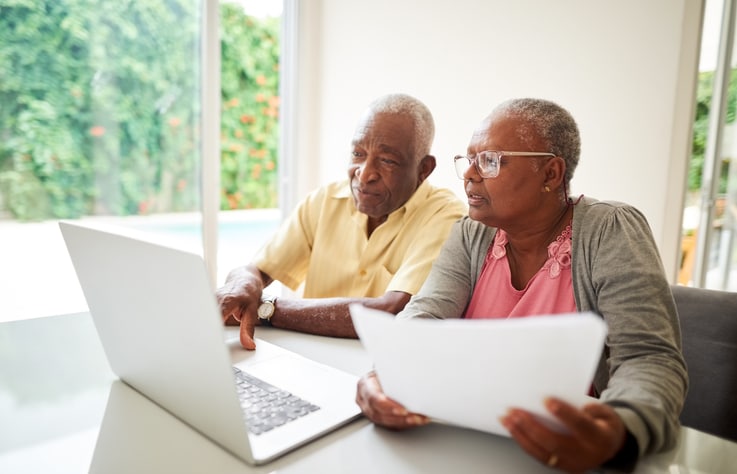From California to Washington D.C., school districts across the nation are returning to remote learning as COVID-19 cases continue to increase. Some schools, in lieu of fully remote models, are opting for a hybrid model that combines part-time in-person learning with remote learning on some days. Others have made no announcement at all. No matter the offering, families are making tough decisions about their children’s education.
In an already inequitable education system, experts have some real concerns about the fate of Black and other marginalized children who are already disproportionately left behind. Ensuring all students across socioeconomic statuses have access and therefore truly have options is the real task at hand.
Educational inequity isn’t a new problem
The funding model of U.S. schools is at the root of racial disparities in educational outcomes. Instead of central and equal funding to schools across the country, U.S. public schools rely on property tax funding. Schools with high Black and Latinx student populations receive approximately $23 billion less than schools with majority white students. In states left highly segregated by racist policies, this leaves students in the poorest areas with schools that have only one tenth of the funding of wealthy school districts. That funding inequity translates to larger class sizes, less experienced teachers, fewer curriculum offerings and no or low-quality books, labs and computers in schools where students of color are most represented. The digital divide in particular is a preexisting issue that disproportionately affects Black and lower-income students, according to the Pew Research Center.
Despite the fact that most school assignments, even pre-pandemic, rely on students’ ability to get to a computer and use the internet for research and email, gaps in access have never been widely addressed by school districts. According to a recent report by EdWeek, only 59% of teachers said they had at least one device for each student. Kate Lindsay, executive director of the summer-school program for underserved middle school students Summerbridge Louisville, says access to technology and internet at home is by far the most significant barrier that stands to worsen existing inequities.
The pandemic is worsening the disparities
During the summer, Lindsay says the program, which is usually in a classroom-like setting, had to switch gears to remote learning due to the pandemic. Steady internet connectivity, access to secure email addresses and a host of other technology concerns made this summer’s program a difficult one. “A lot of times parents weren’t there so students weren’t logged on or the kids wouldn’t turn on their mic or video, so that was a struggle,” she says. For financial reasons, many parents turned down her offer to sign them up for $10 a month internet service, and most students only had access to their school email.
About 1 out of 10 low-income children have little or no access to a computer or device, and twice the percentage of Black households with children in grades K-12 reported they rarely or never have a computer available for online learning than white households. Because schools in the U.S. remain largely racially segregated, with Black students relegated to poorly funded schools with fewer resources, the digital divide during the pandemic will certainly serve to widen the existing performance gap between Black and white students.
“Urban areas that have majority Black and brown students have limited resources, and a lot of schools have been noticing that with this pandemic — but they’re not things that we didn’t know before,” says Alyssa Haymore, an elementary English teacher in New York state. Haymore says getting students logged on to participate in remote learning is a struggle, but for issues beyond connectivity.
“A lot of our students are the children of essential workers, so we have a lot of parents that work in grocery stores or the food industry,” says Haymore who works in a “majority Black and brown school district.” Black women are overrepresented in service sector jobs, and Black and Latinx workers are more likely to be in roles now considered essential. If children of parents working essential jobs are not in the classroom, they’re likely either at home without an adult to help guide instruction or in another child care setting altogether so their parents can work.
Her school district is implementing a hybrid model of learning where students will gather and attend in-person for some days of the week. Meanwhile, Haymore says the predominately white suburban districts nearby are doing fully remote, online learning. While fully remote learning will be a challenge for some underserved students, she worries in-person schooling will increase yet another racial disparity.
“Black and brown people are already dying or already contracting the [COVID-19] virus at a higher rate than our white counterparts,” she says. “And now, more of our brown and Black children are going to be in a position to be in harm’s way.” Haymore says the discussion her school district is having is that “Black and brown kids have different needs,” and that requires them to be in the classroom. “That’s not a different need,” she says. “That’s a lack of resources.”
Closing the gap and ensuring equal access to options
Dr. Khadijah Z. Ali-Coleman, co-founder of Black Family Homeschool Educators and Scholars and co-editor of the book Homeschooling Black Children in the United States, agrees that the choices parents and schools are left with are not ideal but that all parents deserve equal access to be able to make the best choice.
She’s been home-schooling her own daughter on and off over the course of 12 years, noting that there’s been good reason for families with Black children to consider home schooling for many years. “The reasons why Black families chose to home-school prior to COVID-19 was mainly because of many of the things that exist in the school system, environmentally,” she says. Research shows that Black parents are likely to home-school their children because of racism in schools, lack of opportunities for Black students and culturally incompetent curriculums. Parents of Black children who want to opt not to send their children back to school should have that option. No matter the decision parents make during the pandemic, Haymore says a truly equitable situation requires all options be equally viable to parents.
Families shouldn’t have to decide which basic need to prioritize, but that’s the unfortunate situation many are facing. “When we talk about children who are low income, I’m most concerned about those students at home who are depending on meals from school and depending on being cared for because their parents may still have to work even though they’re going to be at home,” says Ali-Coleman. And if the expectation is that children have access to teachers online, then connectivity is an issue, along with others, the states need to address, she says.
Currently, school funding is decided on a state level. School districts are drawn to keep wealthy schools and families in wealthy communities where property values, and subsequently property taxes funneled to those schools, are higher. Surprisingly, only two states require districts to maintain racial and socioeconomic diversity within drawn borders. According to a report by EdBuild, pooling property tax dollars and sharing them across the state or a county would shrink the $23 billion school funding gap by more than $13 billion and 73% of nonwhite students and 76% of low-income students would finally get the equal or greater funding they need to catch up.
The current inequitable way schools are funded fuels a cycle of poverty and helps maintain the conditions that make pandemic schooling options so tough for parents of color and low-income families to figure out. Pandemic schooling options will certainly affect racial and socioeconomic disparities in our education system, but this is a good opportunity to systematically fix the lack of access to resources that makes this such a daunting decision for parents in the first place.






